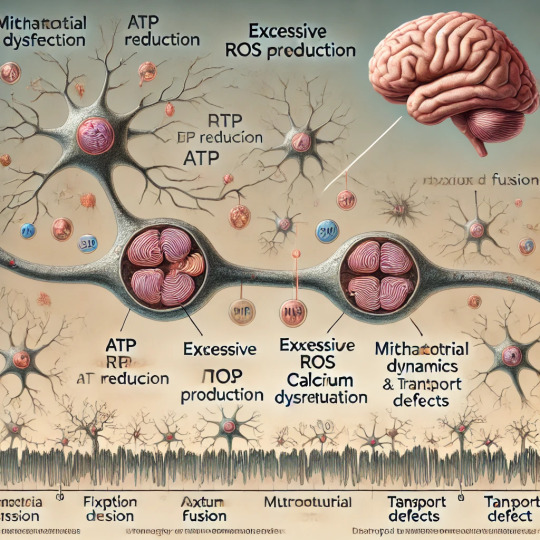#CRISPR/Cas9
Explore tagged Tumblr posts
Text
A recent study reveals the crucial role of the CDK9-55 protein in regulating DNA repair during cell division, which helps prevent mutations that can lead to cancer. The research highlights how CDK9 interacts with other proteins like CDC23, offering new insights for developing targeted cancer therapies aimed at improving DNA repair and slowing tumor growth

0 notes
Text
Edición Genética en la Retina: Un Nuevo Horizonte para el Tratamiento de la Ceguera
#Avances médicos#biotecnología#ceguera#CRISPR/Cas9#edición genética#enfermedades genéticas#genética#Medicina personalizada#modificación del ADN#neurociencia#retinosis pigmentaria#salud ocular
0 notes
Text
Mitochondrial Dysfunction Drives Cognitive Decline
Introduction
Mitochondria, often referred to as the powerhouses of the cell, are crucial organelles responsible for energy production through adenosine triphosphate (ATP) synthesis. Beyond their well-known role in energy metabolism, mitochondria regulate a wide range of cellular processes, including calcium homeostasis, reactive oxygen species (ROS) generation, and apoptosis. When mitochondria malfunction, the consequences can be far-reaching, especially for energy-intensive organs like the brain. Recent research highlights mitochondrial dysfunction as a central factor in cognitive decline, contributing to neurodegenerative diseases such as Alzheimer’s, Parkinson’s, and Huntington’s disease. This article explores the mechanisms by which mitochondrial dysfunction impacts cognitive function and discusses potential therapeutic strategies.
The Brain's Energy Demands and Mitochondrial Function
The human brain, despite accounting for only about 2% of body weight, consumes approximately 20% of the body’s energy. Neurons, the primary cells of the nervous system, rely heavily on mitochondrial ATP to sustain synaptic activity, ion gradient maintenance, and neurotransmitter synthesis. Efficient mitochondrial function is critical for maintaining neuronal health and connectivity, which are foundational for learning, memory, and other cognitive processes.
Mechanisms of Mitochondrial Dysfunction in Cognitive Decline
Reduced ATP Production: Mitochondria produce ATP through oxidative phosphorylation (OXPHOS) in the electron transport chain (ETC). Damage to ETC components, often caused by genetic mutations or oxidative stress, can reduce ATP production. Energy-starved neurons may fail to maintain synaptic function, leading to cognitive impairments.
Excessive ROS Generation: While ROS are natural byproducts of mitochondrial activity and play roles in cell signaling, excessive ROS can damage mitochondrial DNA (mtDNA), proteins, and lipids. This oxidative damage exacerbates mitochondrial dysfunction, creating a vicious cycle that contributes to neuronal degeneration.
Impaired Calcium Regulation: Mitochondria help buffer intracellular calcium levels, which are critical for neurotransmitter release and synaptic plasticity. Dysfunctional mitochondria may fail to regulate calcium, leading to excitotoxicity—a condition where excessive calcium causes neuronal injury and death.
Mitochondrial Dynamics: Mitochondria constantly undergo fission (division) and fusion (joining) to adapt to cellular demands and maintain their integrity. Imbalances in these processes can result in fragmented or overly fused mitochondria, impairing their function and transport within neurons.
Mitochondrial Transport Defects: Neurons have long axons and dendrites that require efficient transport of mitochondria to regions of high energy demand, such as synaptic terminals. Dysfunction in mitochondrial transport mechanisms can disrupt synaptic activity and contribute to cognitive decline.
Mitochondrial Dysfunction in Neurodegenerative Diseases
Alzheimer’s Disease (AD): Mitochondrial dysfunction is a hallmark of AD. Amyloid-beta plaques and tau tangles, characteristic of AD, have been shown to impair mitochondrial function. Elevated ROS levels and reduced ATP production exacerbate neuronal loss and cognitive decline in AD.
Parkinson’s Disease (PD): PD is associated with mutations in genes like PINK1 and PARKIN, which regulate mitochondrial quality control. Impaired mitophagy—the process of removing damaged mitochondria—leads to their accumulation, contributing to dopaminergic neuron degeneration and motor as well as cognitive deficits.
Huntington’s Disease (HD): In HD, mutant huntingtin protein interferes with mitochondrial dynamics and function, resulting in energy deficits and increased oxidative stress. These mitochondrial abnormalities contribute to the progressive cognitive and motor decline observed in HD patients.
Diagnostic and Therapeutic Approaches
Biomarkers of Mitochondrial Dysfunction: Advances in molecular biology have identified potential biomarkers, such as altered mtDNA levels, ROS, and metabolites associated with mitochondrial pathways. These biomarkers can aid in early diagnosis and monitoring of neurodegenerative diseases.
Pharmacological Interventions:
Antioxidants: Compounds like coenzyme Q10, vitamin E, and MitoQ target mitochondrial ROS, reducing oxidative damage and preserving mitochondrial function.
Mitochondrial Biogenesis Enhancers: Agents like resveratrol and PGC-1α activators promote the production of new mitochondria and improve mitochondrial health.
Calcium Modulators: Drugs that stabilize calcium levels, such as memantine, may protect neurons from excitotoxicity.
Gene Therapy: Gene-editing tools like CRISPR/Cas9 offer potential to correct mtDNA mutations or enhance the expression of genes involved in mitochondrial quality control. For example, boosting PINK1 or PARKIN expression could improve mitophagy in PD.
Lifestyle Interventions:
Dietary Interventions: Ketogenic diets and intermittent fasting have been shown to enhance mitochondrial function by promoting efficient energy utilization and reducing ROS.
Exercise: Regular physical activity stimulates mitochondrial biogenesis and reduces oxidative stress, offering neuroprotective benefits.
Sleep Optimization: Adequate sleep is essential for mitochondrial repair and the clearance of damaged proteins, such as amyloid-beta.
Future Directions in Research
Understanding the interplay between mitochondrial dysfunction and cognitive decline opens new avenues for research and therapy. Emerging technologies, such as single-cell transcriptomics and advanced imaging, allow for detailed exploration of mitochondrial dynamics in neurons. Additionally, the development of mitochondria-targeted drugs and nanotechnologies holds promise for precise therapeutic interventions.
Conclusion
Mitochondrial dysfunction plays a pivotal role in driving cognitive decline and is implicated in the pathogenesis of various neurodegenerative diseases. Addressing mitochondrial health through targeted therapies, lifestyle modifications, and early diagnostic measures offers hope for mitigating cognitive impairments and improving quality of life. As our understanding of mitochondrial biology deepens, so too does the potential for innovative treatments that could transform the landscape of neurodegenerative disease management.

#Mitochondrial dysfunction#Cognitive decline#Neurodegenerative diseases#Alzheimer\u2019s disease (AD)#Parkinson\u2019s disease (PD)#Huntington\u2019s disease (HD)#ATP production#Oxidative phosphorylation (OXPHOS)#Reactive oxygen species (ROS)#Mitochondrial DNA (mtDNA)#Calcium homeostasis#Synaptic activity#Excitotoxicity#Mitochondrial dynamics#Mitochondrial fission and fusion#Mitophagy#Mitochondrial transport#Biomarkers#Antioxidants#Mitochondrial biogenesis#Gene therapy#CRISPR/Cas9#Lifestyle interventions#Ketogenic diet#Exercise#Sleep optimization#Neuronal health#Therapeutic strategies
0 notes
Note
Yes!!!! More specifically, dedifferentiation and differentiation via CRISPR/Cas9 will very possible aid in transitions! This would happen by taking the patients somatic cells (because pure stem cells are hard to get to), dedifferentiate them into stem cells, and then differentiate them into the desired type of cell. I could see this being used to aid in SRS ftm, reducing the risk of rejection, or maybe even in face reconstruction surgery (though I’m not familiar with how it works). I’m sure there are other uses, I’m just very familiar with de differentiation and differentiation with CRISPR
Could crispr be utilized in the transition process of trans people?
probably(definitely) not but i’m not a biologist i’m just some guy
24 notes
·
View notes
Text
i do actually think that if you're going to try to engage with stories about the ethics of cloning and genetic engineering, you should have a basic grasp of what eugenics is. like, just because geoff johns showed his ass on this doesn't mean you have to. read a book. read a wikipedia page at least. i promise you these arent ideas that exist in a vacuum and you should probably know what you're talking about before you try to suggest that it's possible to somehow do a plot about a character pondering if their dna makes them more likely to become evil without eugenics.
#rimi talks#again. james watson is a hack as far as what he and crick did to rosalind franklin#but his book dna the story of life has a LOT of interesting history in it and i do recommend it for an overview#of course it's a little outdated as it was published years before modern genetic engineering breakthroughs such as crispr-cas9#but like. for a look at the history of genetics as a field and the american eugenics movement? very informative.#the number of stupid ass white fandom bloggers going haha this WOULD be funny in the notes of that post.#NONE OF YOU know what eugenics means? seriously?
79 notes
·
View notes
Text
Formin Shapes
The role of proteins called formins – key to the assembly of cells' inner scaffold or cytoskeleton – in the mechanics of migration of highly adherent cells is revealed by inactivating certain formins by CRISPR-Cas9 technology
Read the published research article here
Video from work by Jonas Scholz, Till Stephan, Aina Gallemí and Agnes Csiszár, and colleagues
Institute for Biophysical Chemistry, Hannover Medical School, Hannover, Germany
Video originally published with a Creative Commons Attribution 4.0 International (CC BY 4.0)
Published in Science Advances, October 2024
You can also follow BPoD on Instagram, Twitter and Facebook
11 notes
·
View notes
Text
sorry to put this on ur dash
you should help me with my research paper...
"why?" you may be asking...
plsplsplsplsplsplsplsplspls 🥺
this is the link, any answers are greatly appreciated
#tags for reach#genome editing#crispr#research#science#mad scientist#research paper#gay dead wizards#marauders#dead gay wizards from the 70s#marauders era#mauraders#crispr cas9#gene editing#please#pls pls pls
6 notes
·
View notes
Link
DNA code editing, or gene editing, has revolutionized the medical field by providing new avenues for treating diseases that were once considered incurable. The most prominent tool for DNA code editing is CRISPR-Cas9, which has immeasurable possibilities
#Janet Walker#Haute-Lifestyle.com#The-Entertainment-Zone.com#medicalscience#dna#crispr#cas9#gene editing
2 notes
·
View notes
Text
CRISPR-Cas9: A Gene-Editing Revolution
Imagine wielding a microscopic scalpel, sharp enough to snip and edit the very blueprint of life itself. Sounds like science fiction, right? Not anymore! CRISPR-Cas9, a name that has become synonymous with scientific breakthroughs, holds immense potential to revolutionize various fields, from medicine to agriculture. But what exactly is this technology, and how does it work? Let's delve into the world of CRISPR-Cas9, unraveling its complexities and exploring its exciting possibilities.
The story begins not in a gleaming lab, but in the humble world of bacteria. These tiny organisms possess a unique immune system that utilizes CRISPR (Clustered Regularly Interspaced Short Palindromic Repeats) sequences and Cas9 protein. When a virus attacks, the bacteria capture snippets of viral DNA and store them as CRISPR arrays. The Cas9 protein, guided by these arrays, then snips the matching viral DNA, rendering the virus harmless.
Scientists, inspired by this natural marvel, realized they could harness the power of CRISPR-Cas9 for their own purposes. By tweaking the guide RNA (the mugshot), they could target specific locations in any genome, not just viral DNA. This opened a new era of genome editing, allowing researchers to add, remove, or alter genes with unprecedented precision.
CRISPR-Cas9 holds immense promise for various fields:
Medicine: Gene therapies for diseases like cancer, sickle cell anemia, and Alzheimer's are being explored.
Agriculture: Crops resistant to pests, diseases, and climate change are being developed.
Biotechnology: New materials, biofuels, and even xenotransplantation (animal-to-human organ transplants) are potential applications.
As with any powerful technology, CRISPR-Cas9 raises ethical concerns. Modifying the human germline (sperm and egg cells) could have unintended consequences for future generations, and editing embryos requires careful consideration and societal dialogue.
So, is CRISPR-Cas9 the key to unlocking a genetically modified future? The answer is as complex as the human genome itself. But one thing's for sure, this revolutionary tool is rewriting the rules of biology, and the plot is just getting started. CRISPR-Cas9 is still in its early stages, but its potential is immense. As we continue to refine the technology and address ethical concerns, it has the power to revolutionize various fields and improve our lives in countless ways. However, responsible development and open discussion are crucial to ensure this powerful tool benefits humanity without unintended consequences.
#crispr cas9#biotechnlogy#molecular biology#laboratory#gene therapy#gene editing#microbiology#science#DNA#science sculpt#life science#life#biology
6 notes
·
View notes
Text
Avances del CRISPR Cas9 y su Potencial en la Lucha Contra el Cáncer : La cura está en las manos de la edición genética
Exponencial desarrollo en la Edición Genética: El CRISPR Cas9 y su Impacto en la Medicina del Futuro En las últimas décadas, la ciencia y la tecnología han experimentado un progreso sin precedentes, llevando a descubrimientos y desarrollos que una vez parecían pertenecer solo al ámbito de la ciencia ficción. Uno de los avances más revolucionarios en este campo es la tecnología de edición…

View On WordPress
2 notes
·
View notes
Text
happier with this selection this time!
ty for tag!!
@ryleejam @normystical @meowmeowmeowimacat @thenightlightpeep @masqueradeofmimicry
(sorry if ive tagged you before on this i forget)
Challenging you all!
Put your music library on shuffle, then list the first five songs that come up in a poll to let people vote for which one they like the most!
Then tag Tumblr friends to keep the game going!
21K notes
·
View notes
Text
"De la Ciencia Ficción a la Realidad: El Impacto de la Computación Cuántica, Biotecnología y 5G"

View On WordPress
#Biología Sintética#biotecnología#Computación cuántica#CRISPR/Cas9#edición genética#Finanzas#logística#manufactura.#Medicina#redes móviles#tecnología 5G#Tecnologías emergentes
0 notes
Text
Manufacturing of CRISPR-edited primary mouse CAR T cells for cancer immunotherapy - New Study
Manufacturing of CRISPR-edited primary mouse CAR T cells for cancer immunotherapy Summary CRISPR-Cas9 technology can enhance CAR T-cell immunotherapy by improving T-cell function and targeting specificity. This study focuses on a streamlined manufacturing process for generating CRISPR-edited, primary mouse CAR T cells. The process involves electroporation of Cas9 ribonucleoprotein (RNP)…
#Analytical Chemistry#Biological Techniques#Cancer#CAR#Cells#Computational Biology/Bioinformatics#CRISPR-Cas9 genome editing#CRISPRedited#general#immunotherapy#Life Sciences#Manufacturing#Microarrays#mouse#Oncology#Organic Chemistry#Primary#Study
0 notes
Text
How Will AI Integration Transform the Future of the gRNA Market?
The global gRNA Market Size is experiencing significant momentum, having reached a valuation of USD 498.30 Million in 2023. It is projected to soar to USD 2,303.70 Million by 2032, growing at a compound annual growth rate (CAGR) of 19.61% over the forecast period (2024–2032). The growth is largely attributed to expanding applications in CRISPR-based gene editing, increasing investments in genetic research, and rising demand for personalized medicine and diagnostics.
Guide RNA (gRNA), a critical component of CRISPR-Cas9 technology, plays a pivotal role in genome editing by guiding the Cas9 enzyme to the target DNA sequence. As CRISPR becomes more widely adopted across research institutions, biotech firms, and pharmaceutical companies, the demand for customized and synthetic gRNA is rapidly increasing.
Key Market Drivers
Rise in Genetic Disorders and Personalized Therapy: With more genetic conditions being diagnosed earlier due to advanced diagnostics, there's a growing demand for tailored therapies using gene editing tools.
Technological Advancements in CRISPR-Cas Systems: Improvements in precision and efficiency of CRISPR tools, including delivery methods, are further boosting the demand for gRNA.
Growing R&D Investments: Governments and private sectors are investing heavily in biotechnology and life sciences, facilitating more genome-editing research.
Expanding Biotech Startups: An increasing number of startups focusing on genetic engineering are leveraging synthetic gRNAs to streamline their research pipelines.
Applications Beyond Healthcare: Apart from medical applications, CRISPR and gRNA are being adopted in agriculture, animal breeding, and bioengineering.
Regional Outlook
North America held the largest share of the gRNA market in 2023, driven by the presence of major biotech firms, advanced research infrastructure, and supportive regulatory frameworks. Europe follows closely, with significant contributions from countries like Germany, the UK, and France. Meanwhile, the Asia-Pacific region is expected to witness the fastest growth over the forecast period, with China, India, and South Korea becoming major centers for genetic research.
Competitive Landscape
The gRNA market is witnessing increasing collaboration between biotech firms and academic institutions. Key players are focusing on innovation, partnerships, and product differentiation to gain a competitive edge. Some of the notable players in the market include Thermo Fisher Scientific, Agilent Technologies, Merck KGaA, Synthego Corporation, and GenScript.
These companies are developing new synthesis platforms and expanding their product lines to offer customizable gRNA sequences for varied research applications. Moreover, mergers and acquisitions are being seen as strategic moves to bolster capabilities and expand global footprints.
Market Challenges
While the market outlook is promising, it’s not without challenges. High costs associated with CRISPR-based research and ethical concerns regarding genome editing, particularly in humans, are areas that require careful navigation. Regulatory uncertainties in emerging markets also present hurdles that companies must address with strategic foresight.
Future Trends
Integration with AI: AI-driven platforms are being used to design optimal gRNA sequences, increasing efficiency and reducing off-target effects.
Automated Synthesis Platforms: Automation is streamlining gRNA synthesis and improving turnaround times.
Regenerative Medicine: gRNA technologies are finding new applications in tissue engineering and regenerative therapies.
Conclusion
As genome editing continues to redefine modern biology and medicine, the gRNA market is emerging as a central player. From accelerating research to enabling cutting-edge therapeutics, gRNAs are more than just a tool—they are the blueprint for the future of genetic science. With growing investments, expanding use cases, and innovative breakthroughs, the market is poised for explosive growth over the next decade.
About Us:
SNS Insider is one of the leading market research and consulting agencies that dominates the market research industry globally. Our company's aim is to give clients the knowledge they require in order to function in changing circumstances. In order to give you current, accurate market data, consumer insights, and opinions so that you can make decisions with confidence, we employ a variety of techniques, including surveys, video talks, and focus groups around the world.
Contact Us: Jagney Dave – Vice President of Client Engagement Phone: +1-315 636 4242 (US) | +44- 20 3290 5010 (UK) Email: [email protected]
Other Trending Reports
Paper Diagnostics Market
Cell Line Development Market
Genetic Testing Market
Computational Biology Market
0 notes
Text

Editing the Future
Jennifer Doudna – born on this day (19th February)– shared the 2020 Nobel Prize for Chemistry with Emmanuelle Charpentier for developing a genetic engineering technique called CRISPR-Cas9. Based on a naturally occurring defence system used by bacteria to expunge foreign DNA from their genome, CRISPR-Cas9 has revolutionised both biomedical and plant research readily revealing the impact of editing genes in living cells and model organisms, and is being applied in human genome editing to correct disease-causing gene faults and deliver gene therapies
Image by Christopher Michel, on Flickr
Image originally published with a Creative Commons Attribution 2.0 Generic (CC BY 2.0)
You can also follow BPoD on Instagram, Twitter and Facebook
#science#biomedicine#biology#chemistry#nobel prize#crispr#crispr cas9#genome editing#gene editing#born on this day
8 notes
·
View notes
Text
Genetická revoluce v laboratoři?
Vědci z Japonska poprvé úspěšně odstranili třetí chromozom 21 u buněk s Downovým syndromem pomocí technologie CRISPR-Cas9. Upravené buňky následně vykazovaly normalizovanou genovou expresi, zlepšený růst i metabolickou aktivitu. Continue reading Genetická revoluce v laboratoři?

View On WordPress
0 notes